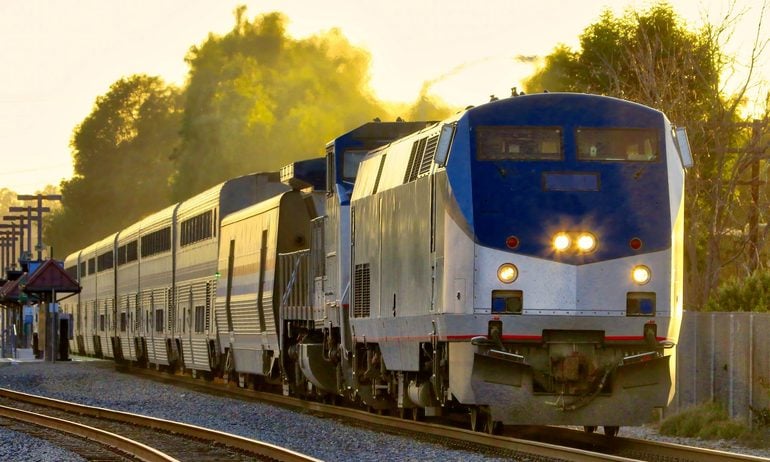Acela vs. Northeast Regional: What’s the Difference?
Amtrak's Acela offers faster travel. Northeast Regional provides broader service at a lower cost.

Many or all of the products on this page are from partners who compensate us when you click to or take an action on their website, but this does not influence our evaluations or ratings. Our opinions are our own.
Whether you’re a frequent train passenger, a train enthusiast or a newbie to the tracks, you’ll quickly discover that Amtrak’s network around the northeast United States (which the brand dubs the “BosWash Megalopolis”) is quite extensive.
If you want to travel anywhere between Boston and Washington D.C., Amtrak has two routes to get you there, called the Acela and the Northeast Regional. These routes differ from each other in important ways.
What is Amtrak?
Amtrak is the United States’ national rail service, and it brings travelers to over 500 destinations in 46 different states.
Some Amtrak routes are used by leisure travelers to see the country. For example, the Empire Builder line brings passengers from Chicago to Seattle, passing over the Mississippi River and through Glacier National Park on a multi-day journey.
Other routes — like the Acela and Northeast Regional — are frequently used by commuters and carry passengers between Boston, New York City and other major East Coast cities.
» Learn more: Credit cards can help you save on buses and trains, too
Amtrak’s Acela line
Acela is Amtrak’s high-speed rail option in the Northeastern corridor, reaching speeds of up to 150 miles per hour during its journey. Acela has several classes of service to choose from, including luxury options, and offers perks like seat selection, at-seat meal service and access to station lounges.
Let’s take a look at the basics of this popular Amtrak route.
Number of stops
Traveling between Boston and Washington D.C., the Acela line makes 13 stops across the following states:
Massachusetts: Boston (South Station and Back Bay Station), Route 128.
Rhode Island: Providence.
Connecticut: New Haven, Stamford.
New York: New York City.
New Jersey: Newark, Metropark.
Pennsylvania: Philadelphia.
Delaware: Wilmington.
Maryland: Baltimore (Penn Station and Thurgood Marshall Airport).
Washington, D.C.
Cost
Since Acela is faster and makes fewer stops than Northeastern Regional, it tends to be more expensive — twice as much on some services, but quadruple the price at busier times.
» Learn more: How to get cheap Amtrak tickets
If your company is paying for it or you want to travel in a premium class of service, the Acela might deliver.
Amtrak’s new, next-generation Acela fleet is scheduled to enter service in the Northeast corridor in 2024.
Classes of service
In keeping with its upscale reputation, Acela trains offer seats only in first and business class — there are no coach seating options available.
All seats come with complimentary seat assignments.
Passenger amenities
All passengers
Complimentary Wi-Fi is available for all travelers, and for those who want to get some work done or dislike distractions, a quiet car is available with advance reservation. An onboard cafe also provides food options to all passengers.
First class
Acela’s first class cabin comes with larger seats, including adjustable headrests, lumbar support, footrests and power outlets. First class passengers also enjoy priority boarding, complimentary meal and beverage service and lounge access in the terminal.
Meals are served at your seat with menus designed by restaurateur Stephen Starr.
Business class
In business class, food and drinks are available at any time in the cafe. Cart service and ordering at your seat is also available on select departures.
Loyalty program earnings
First class passengers receive a 50% bonus and business class passengers earn a 25% bonus on Amtrak Guest Rewards points. Don’t forget you can also earn more points by holding an Amtrak co-branded credit card, too.
Amtrak’s Northeast Regional line
The Northeast Regional line is a convenient way to travel the approximately 700 miles between Virginia Beach and Boston, and it has tickets at various price points. While the Acela hits mainly large cities, this line makes stops at cities and towns throughout the region, making it more accessible for many passengers. That said, all those stops contribute to a slower service.
Let’s take a look at the basics of this affordable Northeast corridor route.
Number of stops
The Northeast Regional makes 55 stops along its route, over four times as many compared to Acela. The states served by the Northeast Regional train line are the same as Acela, with the addition of Virginia. That said, the location of stops in each state may differ based on which line you’re traveling.
These are the states served and number of stops on the Northeast Regional:
Massachusetts: 4 stops.
Rhode Island: 3 stops.
Connecticut: 13 stops.
New York: 2 stops.
New Jersey: 6 stops.
Pennsylvania: 3 stops.
Delaware: 2 stops.
Maryland: 4 stops.
Washington, D.C.: 1 stop.
Virginia: 17 stops.
Cost
Traveling on the Northeast Regional tends to be a cheaper option than Acela as it offers a coach class.
Classes of service
The Northeast Regional line offers two classes of service to its passengers: business class and coach.
Certain overnight routes between Washington, D.C., New York City and Boston also offer private rooms.
Passenger amenities
All passengers
There is free Wi-Fi for passengers, as well as space to stow luggage. Each seat offers a fold-down tray, a reading light and an electric outlet.
There’s also an onboard cafe car offering food and drinks for purchase, and a quiet car.
Business class
The Northeast Regional line business class experience includes extra legroom, larger seats and complimentary non-alcoholic beverages. On many routes, business class passengers receive a complimentary seat assignment.
Coach class
Coach seats are first-come, first-serve, so you’ll want to board early if you want to have your pick of seats.
Loyalty program earnings
Business travelers on the Northeast Regional earn a 25% bonus on Amtrak Guest Rewards points.
» Learn more: What to do when your flight is too expensive
Travel time: Northeast Regional versus Acela
In addition to the varying number of stops each train makes, the two lines also vary in their maximum traveling speeds — the Acela reaches speeds of 150 mph while the Northeast Regional tops out at 125 mph.
Here is the time it takes to travel between a selection of destinations on both routes, along with the difference between the two.
Route | Northeastern Regional | Acela | Time savings |
|---|---|---|---|
Washington, D.C. - Philadelphia | 2 hours. | 1 hour, 40 minutes. | 20 minutes. |
Washington, D.C. - New York City | 3 hours, 30 minutes. | 3 hours. | 30 minutes. |
Washington, D.C. - Boston | 8 hours. | 7 hours. | 1 hour. |
New York City - Philadelphia | 1 hour, 20 minutes. | 1 hour, 10 minutes. | 10 minutes. |
New York City - Boston | 4 hours, 15 minutes. | 3 hours, 45 minutes. | 30 minutes. |
» Learn more: How to find cheap things to do in any city
Amtrak Acela vs. Northeast Regional recapped
Amtrak’s Acela and Northeastern Regional are two train lines with different onboard service offerings, speeds and route networks in the Northeast corridor.
The Acela is typically a bit faster because it makes fewer stops. It also offers a first class service option. Meanwhile, the Northeast Regional train offers access to more communities at cheaper prices due to its wider route network and coach class option.
How to maximize your rewards
You want a travel credit card that prioritizes what’s important to you. Here are some of the best travel credit cards of 2025:
Flexibility, point transfers and a large bonus: Chase Sapphire Preferred® Card
No annual fee: Wells Fargo Autograph® Card
Flat-rate travel rewards: Capital One Venture Rewards Credit Card
Bonus travel rewards and high-end perks: Chase Sapphire Reserve®
Luxury perks: The Platinum Card® from American Express
Business travelers: Ink Business Preferred® Credit Card
Chase Sapphire Preferred® Card
Travel
Dining
🔥 Huge highest-ever bonus on NerdWallet's 2025 Best All-Purpose Travel Rewards Card is back. Don't miss your rare chance to: Earn 100,000 points when you spend $5,000 on purchases in the first three months. That's worth at least $1,250 toward travel booked through Chase.

